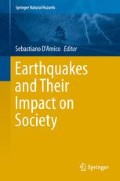Abstract
The mapping of earthquake perception area is useful to determine how many people have felt it. This is an important issue because even moderate magnitude earthquakes can affect critical communication infrastructures. However theoretical estimates of instrumental intensity distribution, derived from ground motion parameters (e.g. ShakeMaps), maybe poorly correlated with the actual earthquake perception. Furthermore, the number of people who felt the earthquake depends strongly on the spatial distribution of the population density. In recent years there has been a growing interest in the data mining of citizen-provided information from social networks, Internet accesses and web-based macroseismic surveys aimed at detecting, locating and characterizing the macroseismic field of moderate and strong earthquakes. Here we propose a strategy to retrieve in real-time useful information about the area where an earthquake has been perceived and how many people felt it, using data mining of Twitter streams. We show that using a proper normalization of these data allows a quantitative definition of an Earthquake Perception Index based on Twitter posts (EPIT). This index shows a good correlation with ground motion parameters and macroseismic data and hence allows a rapid but realistic mapping of the perception area.
Access this chapter
Tax calculation will be finalised at checkout
Purchases are for personal use only
References
Allen, R. M. (2012). Transforming earthquake detection? Science, 335(6066), 297–298.
Bindi, D., Pacor, F., Luzi, L., Puglia, R., Massa, M., Ameri, G., & Paolucci, R. (2011). Ground motion prediction equations derived from the Italian strong motion database. Bulletin of Earthquake Engineering, 9(6), 1899–1920.
Bossu, R., Mazet-Roux, G., Douet, V., Rives, S., Marin, S., & Aupetit, M. (2008). Internet users as seismic sensors for improved earthquake response. Eos, Transactions, American Geophysical Union, 89(25). http://www.agu.org/pubs/crossref/2008/2008EO250001.shtml.
Bossu, R., Gilles, S., Mazet-Roux, G., Roussel, F., Frobert, L., & Kamb, L. (2011). Flash sourcing, or rapid detection and characterization of earthquake effects through website traffic analysis. Annals of Geophysics, 54(6). doi:10.4401/ag-5265.
Bossu, R., Lefebvre, S., Cansi, Y., & Mazet-Roux, G. (2014). Characterization of the 2011 Mineral, Virginia, earthquake effects and epicenter from website traffic analysis. Seismological Research Letters, 85(1). doi:10.1785/0220130106.
Burks, L., Miller, M., & Zadeh, R. (2014). Rapid estimate of ground shaking intensity by combining simple earthquake characteristics with tweets. Proceedings of the 10th National Conference in Earthquake Engineering, Earthquake Engineering Research Institute, Anchorage, AK.
D’Auria, L., & Giudicepietro, F. (2013). TwiFelt: Real-time mapping of earthquake perception areas through the analysis of Twitter streams. Rapporti Tecnici INGV n.254 ISSN 2039-7941 (PDF available at. http://istituto.ingv.it/l-ingv/produzione-scientifica/rapporti-tecnici-ingv/rapporti-tecnici-2013/2013-05-09.2596813703).
Earle, P. S., Bowden, D. C., & Guy, M. (2011). Twitter earthquake detection: Earthquake monitoring in a social world. Annals of Geophysics, 54(6). doi:10.4401/ag-5364.
Earle, P., Guy, M., Buckmaster, R., Ostrum, C., Horvath, S., & Vaughan, A. (2010). OMG earthquake! Can Twitter improve earthquake response? Seismological Research Letters, 81(2), 246–251.
Mercalli, G. (1902). Sulle modificazioni proposte alla scala sismica De Rossi-Forel. Società tipografica modenese.
Moumni, B., Frias-Martinez, V., Frias-Martinez, E. (2013). Characterizing social response to urban earthquakes using cell-phone network data: The 2012 Oaxaca Earthquake. PURBA 2013: Workshop on Pervasive Urban Applications. UbiComp’13, September 8–12, 2013, Zurich, Switzerland.
Sakaki, T., Okazaki, M., & Matsuo, Y. (2010). Earthquake shakes Twitter users: Real-time event detection by social sensors. In WWW2010, April 26–30, Raleigh, North Carolina.
Sakaki, T., Okazaki, M., & Matsuo, Y. (2013). Tweet analysis for real-time event detection and earthquake reporting system development. IEEE Transactions on Knowledge and data engineering, 25(4). doi:10.1109/TKDE.2012.29.
Sbarra, P., Tosi, P., & De Rubeis, V. (2009). Web-based macroseismic survey in Italy: Method validation and results. Natural Hazards, 4, 563–581. doi:10.1007/s11069-009-9488-7.
Sysomos. (2014). Inside Twitter: An In-depth look inside the Twitter World. http://www.sysomos.com/docs/Inside-Twitter-BySysomos.pdf.
Thelwall, M., Buckley, K., & Paltoglou, G. (2011). Sentiment in Twitter events. Journal of the American Society for Information Science Technology, 62(2), 406–418. doi:10.1002/asi.21462.
Vervaeck, A. (2011). Mobile communications and earthquakes: A very “disturbing” marriage. http://earthquake-report.com/2011/09/16/mobile-communications-and-earthquakes-a-very-disturbing-marriage.
Young, J. C., Wald, D. J, Earle, P. S., & Shanley, L. A. (2013). Transforming earthquake detection and science through citizen seismology. Washington, DC: Woodrow Wilson International Center for Scholars. (http://www.wilsoncenter.org/publication-series/commons-lab).
Wald, D. J., Quitoriano, V., Dengler, L. A., & Dewey, J. W. (1999). Utilization of the Internet for rapid community intensity maps. Seismology Research Letters, 70, 680–697.
Author information
Authors and Affiliations
Corresponding author
Editor information
Editors and Affiliations
Rights and permissions
Copyright information
© 2016 Springer International Publishing Switzerland
About this chapter
Cite this chapter
D’Auria, L., Convertito, V. (2016). Real-Time Mapping of Earthquake Perception Areas in the Italian Region from Twitter Streams Analysis. In: D'Amico, S. (eds) Earthquakes and Their Impact on Society. Springer Natural Hazards. Springer, Cham. https://doi.org/10.1007/978-3-319-21753-6_26
Download citation
DOI: https://doi.org/10.1007/978-3-319-21753-6_26
Published:
Publisher Name: Springer, Cham
Print ISBN: 978-3-319-21752-9
Online ISBN: 978-3-319-21753-6
eBook Packages: Earth and Environmental ScienceEarth and Environmental Science (R0)

